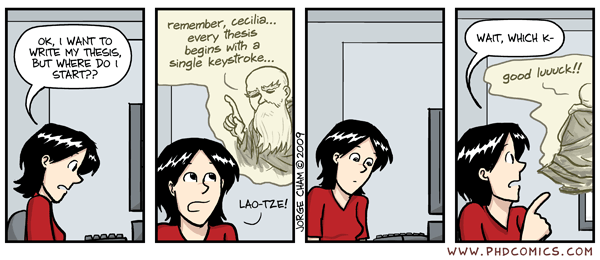How many times a week do you think “I should be writing”?
For some reason, even when reaching the end of their PhD, most people have trouble actually starting to write the thesis.
- “Just a little more data.”
- “There’s just one more source I have to cite.”
- Or the seemingly rational “but I don’t have my key results yet!”
The truth is, we procrastinate on starting because we don’t know where or how to start. We imagine The Thesis as a complete whole, as a monolithic slab of pages; and we cringe and avert our inner eye. If you’re at the beginning of the PhD, you also feel it’s probably pointless to start, because you don’t have results or even a firm topic.
Sorry, but these are all excuses. When should you start?
Whether you’ve just chosen a supervisor, or you’re ABD and a year away from having your funding cut off, the answer is the same: Start today.
Easier said than done? Not really.
After all, a thesis is nothing more than a big document. Whether you’re writing in Word or LaTeX, it’s just a file of text, like any other.
But if we imagine that we have to write a coherent argument over 200 pages, and we’re starting at page 1, it’s no wonder we’re overwhelmed! That’s like saying “You have no idea where you want to go in these woods, but you have to take the first step right now. Here’s a backpack with a few supplies. Go on, get moving!”
If a journey of a thousand miles begins with a single step, you wonder “What if I step in the wrong direction? I could end up 2000 miles from where I’m supposed to be!”
The problem here is linear thinking. Because our documents are linear, we start to think linearly, and so anything big instantly becomes overwhelming. By thinking “non-linearly” I don’t mean to jump around, and write things out of order. I mean that you need to think holistically, and in slowly increasing detail.
Plant Your Seed, Watch It Grow
The solution is simple.
Write a mini-thesis.
Then grow it, daily.
Imagine the following:
What if your thesis only needed to be 100 words long?
Oh, and quality doesn’t matter, because you’ll have regular feedback and hundreds of revisions. Also, you don’t have to worry too much about “making a unique contribution”… even a semi-coherent plan to get results is enough.
Could you do it? Absolutely!
Once you’ve done that, all you have to do is expand and elaborate on your mini-thesis!
Here’s how it works.
- Write your title.
- Write your seed: the “100 word thesis”.
- In a separate document (or, if you’re using Gingko, right there next to the seed), write a slightly more detailed version of each section you mentioned in the seed.
- Repeat, each time expanding and refining what you have, rearranging as necessary.
Of course, Gingko is ideal for this (after all, I designed it while struggling with my own PhD in physics). But you can use any other word processor as well (my competitor Scrivener is a good alternative). Simply create a new view/document/column, so you can have your current iteration to the left, and the version one you’re expanding on to the right.
In fiction, this is sometimes called the “Snowflake Method” . But the principle is far deeper, and can be found in all kinds of different fields. For instance, artists often make small sketches, which expand to bigger studies, before tackling the full-sized canvas. Digital Images are often compressed so that no matter how small a chunk of the file you get, you still have the whole picture (albeit at lower-resolution). For the physicists and mathematicians among you, all we’re doing is taking the writing process from linear space, to Fourier space. I call this process “Sketching with Words“, but I digress…
Growing your thesis has a number of advantages over other methods.
- Instantly kills overwhelm; it’s easy to start small.
- You always see the question you’re trying to answer, making it less likely your thesis will turn into a “project” instead. A “project” thesis is much harder to work on, trust me.
- You always have a sense of the whole, lending coherence to your argument.
- You can get early feedback and expose major flaws, before you’ve written walls of text. This makes it easier to get feedback (less to read), and to make changes (less to change, and you’re less attached to your ideas).
- At each pass, you know exactly where you’re going, because you’ve already written that section before (though not in as much detail).
So, now you have no excuse. If you can write a shoddy 100 words, you can start your thesis today. Just remember the steps:
- Start with a small seed.
If you’re using Gingko, visit the “Organic Thesis” template here, and click “Copy at the top”. - Sprinkle words on it every day.
Start a “Mini-Habit” of writing daily. - Expose it to sunlight (feedback) regularly.
Hint: you can share a read-only private link to get feedback. - Watch your thesis grow, organically.
If you liked this post, sign up to the newsletter below. Or simply give Gingko a try today.
